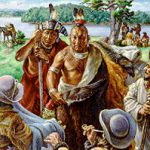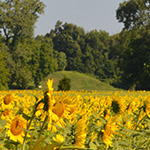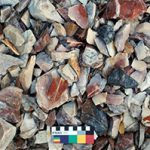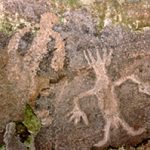The Arkansas Archeological Survey provides services and materials that can help Arkansas educators and students understand Arkansas’s past. Here are some of the ways we assist K-12 education.
We have available on our website a variety of Classroom Materials that can be used by teachers for lesson preparation or as student handouts. There are downloadable handouts on a wide range of topics about Arkansas archeology (both prehistoric and historic), Arkansas Indians, and some of the important sites and artifacts in Arkansas.
Books & Handouts
We also have several general-audience books that can help teachers by providing a solid background on Arkansas Indians and some of our state’s most interesting prehistoric cultural resources. Paths of Our Children: Historic Indians of Arkansas tells the story of the Native American tribes that have lived in Arkansas from the time of first European contact up to the present day. Rock Art in Arkansas outlines recent studies by archeologists of the painted pictographs and carved petroglyphs that are found in some parts of the state, forming one of the best concentrations of this early art form in the Southeast. Visit our Publications page for more info.
5th Grade Social Studies Curriculum: Gathering, Gardening, & Agriculture
 We encourage teachers (and anyone else who is interested!) to visit our Gathering, Gardening, and Agriculture comprehensive 5th grade social studies curriculum for Arkansas’s teachers. This curriculum, aligned with the 5th grade Arkansas Department of Education (ADE) Social Studies Curriculum Framework. Because of its interdisciplinary nature, many upper elementary and secondary educators find archeology an engaging way to teach social studies, history, and science. This curriculum offers lessons and activities to help teachers and students explore pre-Columbian societies and early European exploration, while highlighting specific sites and events in Arkansas. It will teach students about pre-Columbian societies and early European exploration through the common experience of food! This curriculum is available free to educators and includes background information and student activities. Our Gathering, Gardening, and Agriculture website includes additional teaching resources to accompany the curriculum. We also offer credit-bearing teacher workshops on this curriculum (contact Michelle Rathgaber at mmrathga@uark.edu for more information on workshops). Teaser: Many people do not know that the southeastern U.S. was one of ten independent centers of plant domestication in the world, and much of the archeological evidence of this early domestication of indigenous plants comes from right here in northwest Arkansas.
We encourage teachers (and anyone else who is interested!) to visit our Gathering, Gardening, and Agriculture comprehensive 5th grade social studies curriculum for Arkansas’s teachers. This curriculum, aligned with the 5th grade Arkansas Department of Education (ADE) Social Studies Curriculum Framework. Because of its interdisciplinary nature, many upper elementary and secondary educators find archeology an engaging way to teach social studies, history, and science. This curriculum offers lessons and activities to help teachers and students explore pre-Columbian societies and early European exploration, while highlighting specific sites and events in Arkansas. It will teach students about pre-Columbian societies and early European exploration through the common experience of food! This curriculum is available free to educators and includes background information and student activities. Our Gathering, Gardening, and Agriculture website includes additional teaching resources to accompany the curriculum. We also offer credit-bearing teacher workshops on this curriculum (contact Michelle Rathgaber at mmrathga@uark.edu for more information on workshops). Teaser: Many people do not know that the southeastern U.S. was one of ten independent centers of plant domestication in the world, and much of the archeological evidence of this early domestication of indigenous plants comes from right here in northwest Arkansas.
Lesson Plans
We know that sometimes teachers do not have time for a full curriculum and want something more interactive than a book or handout to engage their students. To that end we are putting together individual lesson plans with available hands-on components for teachers and anyone else who may be interested. The lesson plans are broken down by grade level and list the Arkansas Educational Standards that they meet. There are also PowerPoint presentations with full notes available for download to make incorporating the lesson into class time as seamless as possible. For our Raw Materials lessons we also have a box of hands-on materials available at each of our research stations for teachers to borrow. We love being able to make archeology accessible to everyone on every level, so we encourage teachers to grab a box from their nearest research station and try out the lessons with their students. (The Raw Materials boxes were funded by a grant from the Arkansas Archeological Society's Bill Jordan Public Education Fund.)
Raw Materials/Natural Resources Lesson Plans
Grades K-2 Lesson Plan (.docx) and PowerPoint File
Grades 3-5 Lesson Plan and PowerPoint File
Grades 6-8 Lesson Plan and PowerPoint File
Grades 9-12 Lesson Plan and PowerPoint File
Websites
We have five special focus education websites that can be used by educators and students for learning. All five websites are linked from our main home page as well as the footer of every page.
 The most widely used of these has been “Indians of Arkansas,” a website that tells the stories of Native American occupation in the state from earliest times to the recent past. Using original texts, maps, and artworks, this website engages learners at all levels and covers 30,000 years of Native American history in Arkansas. Alongside the archeological “story” of Arkansas Indians, the website presents Indians’ own stories of their history as preserved in oral traditions. Most important for classroom use, it also includes writing prompts and beginner, intermediate, and advanced learning exercises that encourage students to use the material they have read and studied on the website to develop critical thinking and research and study skills.
The most widely used of these has been “Indians of Arkansas,” a website that tells the stories of Native American occupation in the state from earliest times to the recent past. Using original texts, maps, and artworks, this website engages learners at all levels and covers 30,000 years of Native American history in Arkansas. Alongside the archeological “story” of Arkansas Indians, the website presents Indians’ own stories of their history as preserved in oral traditions. Most important for classroom use, it also includes writing prompts and beginner, intermediate, and advanced learning exercises that encourage students to use the material they have read and studied on the website to develop critical thinking and research and study skills.
 "Bluff Shelters of the Arkansas Ozarks" - Ozark bluff shelters are widely recognized as an archeological resource of great importance. With their combination of rarely preserved perishables and deeply stratified deposits, they are an unparalleled source of information about textile arts, plant domestication, and chronology in the midcontinent. Unfortunately, these sites are increasingly endangered by looting, and potential knowledge about the past is being destroyed. Learn more about these amazing Arkansas resources and the information they hold.
"Bluff Shelters of the Arkansas Ozarks" - Ozark bluff shelters are widely recognized as an archeological resource of great importance. With their combination of rarely preserved perishables and deeply stratified deposits, they are an unparalleled source of information about textile arts, plant domestication, and chronology in the midcontinent. Unfortunately, these sites are increasingly endangered by looting, and potential knowledge about the past is being destroyed. Learn more about these amazing Arkansas resources and the information they hold.
 The Arkansas Archeological Survey’s “Gathering, Gardening, and Agriculture” website is designed as a resource for teachers interested in using our 5th grade social studies curriculum in their classes. This curriculum explores Native American, and early Euro-American plant use in the southeastern United States, with specific emphasis on sites in Arkansas. It is available on this website. The “Gathering, Gardening, and Agriculture” website is also intended to be a companion for the Survey’s Native Gardens at the Plum Bayou Station, Parkin Station, and the Research Station at the Winthrop Rockefeller Institute. The “Gardens” section includes photographs and information regarding the types of plants used by Indigenous people who lived in what is now Arkansas.
The Arkansas Archeological Survey’s “Gathering, Gardening, and Agriculture” website is designed as a resource for teachers interested in using our 5th grade social studies curriculum in their classes. This curriculum explores Native American, and early Euro-American plant use in the southeastern United States, with specific emphasis on sites in Arkansas. It is available on this website. The “Gathering, Gardening, and Agriculture” website is also intended to be a companion for the Survey’s Native Gardens at the Plum Bayou Station, Parkin Station, and the Research Station at the Winthrop Rockefeller Institute. The “Gardens” section includes photographs and information regarding the types of plants used by Indigenous people who lived in what is now Arkansas.

"Arkansas Novaculite” focuses on the long history of quarrying, toolmaking, and trade of Arkansas novaculite, a stone found in the Ouachita Mountains. Native Americans used novaculite for their chipped stone arrowheads and other tools for thousands of years, while Euro-American settlers developed an industry that quarried novaculite for whetstones. This website also includes a database for archeological researchers and learning exercises that teachers can use for reading comprehension and to reinforce the scientific information presented in the website.

“Rock Art in Arkansas” is a companion website to our book. It includes an image gallery, stories geared for kids, articles, and interpretations of rock art that help to explain how Native Americans used art forms to express their beliefs about the world. Other articles on this website explore some of the ways scientists and historians try to arrive at these conclusions, and the challenges that can arise when interpreting art and symbolism from a different culture.
Classroom Visits
 Our professional staff are available to visit schools for talks and demonstrations. On the home page of our website you can find the “schedule a speaker” button which will lead you to our contact information. We have professional archeologists at research stations in ten locations around the state, so chances are there is an archeologist near you, and they are all experienced at classroom visits. A wide range of topics are available, including Career Day presentations on the practice of archeology, talks on the prehistory and early history of Arkansas, sites and artifacts, demonstrations of early hunting and farming technology with replicated tools and weapons, Indian tribes who lived in Arkansas, the first encounters of Europeans and Indians in the state, and many others. We also sometimes arrange tours for smaller school groups of our facility in Fayetteville.
Our professional staff are available to visit schools for talks and demonstrations. On the home page of our website you can find the “schedule a speaker” button which will lead you to our contact information. We have professional archeologists at research stations in ten locations around the state, so chances are there is an archeologist near you, and they are all experienced at classroom visits. A wide range of topics are available, including Career Day presentations on the practice of archeology, talks on the prehistory and early history of Arkansas, sites and artifacts, demonstrations of early hunting and farming technology with replicated tools and weapons, Indian tribes who lived in Arkansas, the first encounters of Europeans and Indians in the state, and many others. We also sometimes arrange tours for smaller school groups of our facility in Fayetteville.
The Arkansas Archeological Survey uses the latest technology in its practice of archeology. For this reason, at the upper levels, our staff can give interesting presentations on applications of GIS and near-surface geophysical prospection to map the features of archeological sites even before we dig.
 We are always developing new research, and this means our archeologists can bring new topics to the classroom. For example, some of our staff have been revisiting the old-fashioned concept of the “Ozark bluff-dwellers” and bringing a new understanding to these famous northwest Arkansas sites. Others have been developing experimental gardens to study the plants that were important to American Indians in the past. These gardens have been established at three sites around the state. Because we have projects all over the state, there is often some kind of research project we can talk about that is focused on the area where you live, bringing history alive for your students.
We are always developing new research, and this means our archeologists can bring new topics to the classroom. For example, some of our staff have been revisiting the old-fashioned concept of the “Ozark bluff-dwellers” and bringing a new understanding to these famous northwest Arkansas sites. Others have been developing experimental gardens to study the plants that were important to American Indians in the past. These gardens have been established at three sites around the state. Because we have projects all over the state, there is often some kind of research project we can talk about that is focused on the area where you live, bringing history alive for your students.
So check out our website, and if you would like an archeologist to visit your school, give us a call!
Save
Save
Save
Save
Save
Save
Save

